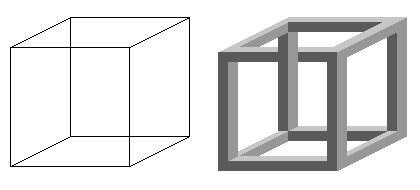The Necker Cube is an optical illusion first published in 1832 by Swiss crystallographer Louis Albert Necker.
Ambiguity[]
The Necker Cube is an ambiguous line drawing. It is a wire-frame drawing of a cube in isometric perspective, which means that parallel edges of the cube are drawn as parallel lines in the picture. When two lines cross, the picture does not show which is in front and which is behind. This makes the picture ambiguous; it can be interpreted two different ways. When a person stares at the picture, it will often seem to flip back and forth between the two valid interpretations (so-called multistable perception).

Necker cube on the left, impossible cube on the right.
The effect is interesting because each part of the picture is ambiguous by itself, yet the human visual system picks an interpretation of each part that makes the whole consistent. The Necker Cube is sometimes used to test computer models of the human visual system to see if they can arrive at consistent interpretations of the image the same way humans do.
Humans do not usually see an inconsistent interpretation of the cube. A cube whose edges cross in an inconsistent way is called an impossible object, specifically an impossible cube.
With the cube on the left, most people see the lower-left face as being in front most of the time. This is possibly because people view objects from above, with the top side visible, far more often than from below, with the bottom visible, so the brain "prefers" the interpretation that the cube is viewed from above.
There is evidence that by focusing on different parts of the figure one can force a more stable perception of the cube. The intersection of the two faces that are parallel to the observer forms a rectangle, and the lines that converge on the square form a "y-junction" at the two diagonally opposite sides. If an observer focuses on the upper "y-junction" the lower left face will appear to be in front. The upper right face will appear to be in front if the eyes focus on the lower junction (Einhauser, et al., 2004).
The Necker cube can shed light on the human visual system. Sidney Bradford, blind from birth but regaining his sight following an operation at age 52, did not perceive the ambiguity that normally sighted observers do.
Assessment |
Biopsychology |
Comparative |
Cognitive |
Developmental |
Language |
Individual differences |
Personality |
Philosophy |
Social |
Methods |
Statistics |
Clinical |
Educational |
Industrial |
Professional items |
World psychology |
Cognitive Psychology: Attention · Decision making · Learning · Judgement · Memory · Motivation · Perception · Reasoning · Thinking - Cognitive processes Cognition - Outline Index
Epistemology[]
The Necker Cube is used in epistemology (the study of knowledge) and provides a counter-attack against naïve realism. Naive realism (aka direct or common-sense realism) states that the way we perceive the world is the way the world actually is.
The Necker cube seems to disprove this claim: we see a cube, but really, there is no cube there at all: only a two-dimensional drawing of twelve lines. We see something which is not really there, thus (allegedly) disproving naïve realism. This criticism of naive realism supports representative realism.
External links[]
- Did you notice the top side of the cube?
- history of the cube and a Java applet
- modelling human perception of the cube
- Necker Cube: A Visual Illusion at cut-the-knot
- Explanation of the Necker cube and other gestalt phenomena
References[]
fr:Cube de Necker nl:Necker-kubus zh:奈克方塊
| This page uses Creative Commons Licensed content from Wikipedia (view authors). |